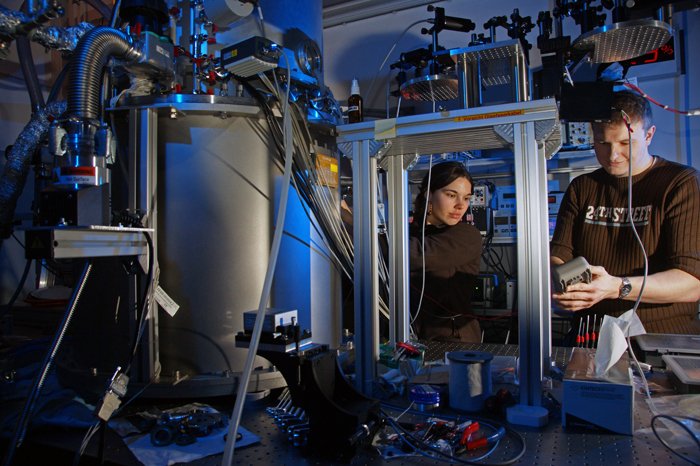What moves space and time
Gravitational wave research in Germany to receive continued support: German Research Foundation (DFG) extends Collaborative Research Centre (CRC)/Transregio “Gravitational Wave Astronomy”. German Research Foundation to provide the CRC with eight million euros for a further four years.
This will also benefit the Max Planck Institute for Gravitational Physics: 1.443 million euros have been earmarked for the Potsdam-Golm site, which includes three and one half postdoc positions. The Sub-Institute Hannover will receive, together with the Institute for Gravitational Physics Leibniz Universität Hannover 1.784 million euros. This sum includes five doctoral student positions and one half postdoc position. In Hannover, the researchers operate the GEO600 gravitational wave detector, for which they develop increasingly sensitive measurement technologies, which find use throughout the world. With the ATLAS computer cluster, the scientists analyze the data from GEO600, as well as from the LIGO (USA) and Virgo (Italy) detectors. In Potsdam, the physicists develop analytical methods for the gravitational wave data that will be used for the planned LISA space observatory, and will simulate how gravitational waves arise from the merging of black holes and neutron stars.
Joint press release from Friedrich-Schiller-Universität Jena, Eberhard Karls Universität Tübingen, Leibniz Universität Hannover and the Max Planck Institute for Gravitational Physics, and for Astrophysics.

Jena (24.11.10) “Gravitational waves are as much a part of gravity, as light waves are to electromagnetism,” according to Prof. Dr. Bernd Brügmann from Friedrich-Schiller-Universität Jena. Gravitational wave astronomy goes beyond the place where astronomy with electromagnetic waves reaches its limits, explains the scientist, who is the holder of the chair for gravitational theory. “Gravitational waves carry, for example, information about black holes, from the depths of supernova explosions or even from the Big Bang, the birth of our universe.” They are, however, extremely difficult to measure.
The German Research Foundation (DFG) has now approved around eight million euros for the Collaborative Research Center/Transregio 7 (SFB/TR7) “Gravitational Wave Astronomy”. “This enables the research collective to continue its successful work, which began in 2003, until 2014 as well as to finance 30 scientist positions, among other things,” says Prof. Brügmann, spokesperson for the research collective. The SFB/TR7 includes scientists from Friedrich-Schiller-Universität Jena, Eberhard Karls Universität Tübingen, Leibniz Universität Hannover and the Max Planck Institute for Gravitational Physics in Hannover and Potsdam, and for Astrophysics in Garching. Around 80 physicists, astronomers and mathematicians work in the 17 subprojects and will continue to “chase down” gravitational waves in the coming four years. The SFB/TR7 also has a positive effect for young scientists in Germany. It enables the establishment of clusters, the appointment of renowned top researchers to participating universities and institutes, and the education of budding physicists, especially in the areas of gravitational physics and relativistic astrophysics.
The goal of the SFB/TR7 is to directly measure gravitational waves and to research them both theoretically and experimentally. “These waves are oscillations from space and time that were caused by powerful cosmic events,” explains Prof. Dr. Kostas Kokkotas from Eberhard Karls Universität Tübingen. Predicted as early as 1916 by Albert Einstein in his general theory of relativity, to date they have only been detected indirectly, for instance as energy losses from objects which emit gravitational waves. “Neutron stars, extremely compact objects that can arise at the end of the development of a star, are such objects,” says Kokkotas. “Neutron stars are very interesting sources for gravitational radiation, especially when they rotate very quickly. In order to detect their radiation one has to know exactly what this radiation looks like and under which conditions it is generated. To this effect, we carry out very complex simulation calculations.”
The fact that it has not yet been possible to directly measure gravitational waves has to do primarily with the extremely low intensity of these signals. However, a breakthrough is on the horizon: “From 2012, a particularly sophisticated laser technology will be installed in the large-scale American detectors, which we also developed on the German-British GEO600 gravitational wave detector in Ruthe near Hannover within the framework of SFB/TR7. From 2015, these detectors will be so sensitive that detection should then be possible within a few year’s time,” according to Prof. Dr. Karsten Danzmann from Leibniz Universität Hannover, which operates GEO600. Danzmann is also Director at the Max Planck Institute for Gravitational Physics in Potsdam and Hannover.
For the next generation of detectors, the SFB/TR7 scientists have developed innovative optical components of unprecedented quality. In the first two SFB/TR7 funding periods, Brügmann and his colleagues were moreover able to compute the movement of two black holes orbiting around each other in their dynamic phase with a high degree of precision.
Press and public relations activities
Within the framework of SFB/TR7 is a project related to press and public relations activities with the goal of introducing the work and making this complex topic accessible for non-scientists. To this effect, public events are organized, as well as a mobile exhibition entitled “Einstein-Waves-Mobile”, which pays visits to institutions such as schools and planetariums. An accompanying website is also available for further information. All activities in this project are intended to entertain and, at the same time, provide scientific substance. Those interested can become acquainted with the topic through play, but will also always find a number of more in-depth explanations.
